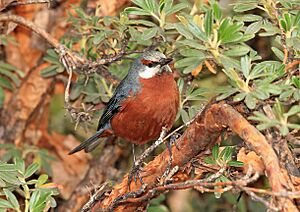Giant conebill facts for kids
Quick facts for kids Giant conebill |
|
|---|---|
 |
|
| Conservation status | |
| Scientific classification | |
| Genus: |
Conirostrum
|
| Species: |
binghami
|
 |
|
| Synonyms | |
|
Oreomanes fraseri |
|
The giant conebill (Conirostrum binghami) is a unique small bird. It belongs to the tanager family. This bird is related to other conebills, but it's bigger. It also searches for food in a special way, much like a nuthatch bird.
Contents
What Does the Giant Conebill Look Like?
The giant conebill is about 15 centimetres (5.9 in) long. That's about the length of a pen. It weighs between 22–27 grams (0.78–0.95 oz), which is very light! Its back is grey, and its belly is a deep chestnut brown. It also has a clear white patch on its cheeks.
Where Do Giant Conebills Live?
These birds live high up in the Andes mountains. You can find them in countries like Colombia, Ecuador, Peru, and Bolivia. They especially love to live in Polylepis trees. These trees are part of the Rosaceae family, which also includes roses and apples!
Giant Conebill Behavior and Diet
Giant conebills can be seen alone or in small groups. These groups usually have five birds or fewer. They are very clever at finding food. They peel off the bark of Polylepis trees to find insects hiding underneath. They also enjoy eating tiny insects called aphids. Sometimes, they even drink sweet liquids from Gynoxys plants.
Reproduction and Life Cycle
Giant conebills are seasonal breeders. This means they only nest during certain times of the year. In places like Bolivia, they start nesting when the rainy season begins, usually from September to December. Their nest is shaped like an open cup. They build it on the branches of Polylepis trees.
On average, a female giant conebill lays about two eggs. Both parents work together to care for their young. They take turns incubating (keeping warm) the eggs. Once the chicks hatch, both parents feed them. They also keep the nest clean by removing waste.
Why Are Giant Conebills Endangered?
Sadly, the number of giant conebills is going down. This is mainly because their home, the Polylepis woodland, is being destroyed. When their habitat is broken into smaller pieces, it's called habitat fragmentation. This makes it harder for the birds to find food and safe places to live.
Taxonomy: How Scientists Name Birds
Scientists use special names to classify animals. The giant conebill was first described in 1860 by a scientist named Philip Sclater. He gave it the name Oreomanes fraseri. Later, in 2014, new studies showed that the giant conebill was actually very similar to birds in the Conirostrum group.
Because the name Conirostrum was used earlier (in 1838), it became the official group name. This meant the giant conebill's name had to change. It was renamed Oreomanes binghami in 1919 by Frank Chapman. This new name honored Hiram Bingham III, who was famous for exploring Machu Picchu. The giant conebill is considered a single species, meaning it doesn't have different types or subspecies.


